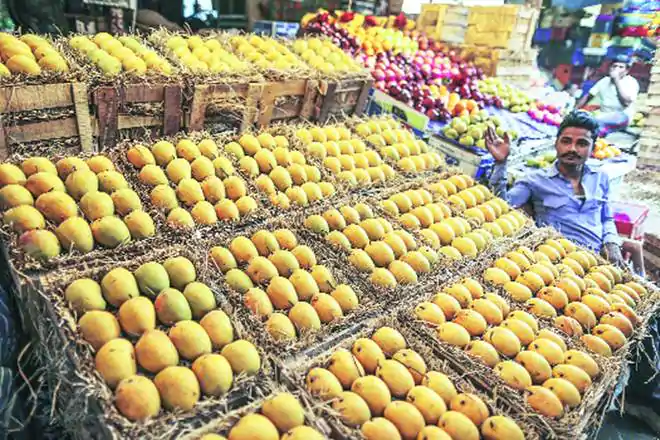Mango export is a major source of income for farmers in the state of Maharashtra. With the start of the season, the state has started exporting mangoes to Gulf countries. So far 100 tonnes of mangoes have been exported through the agricultural marketing board of the state. Vashi agricultural market produce committee, one of the largest mango markets in the state, receives 70,000 boxes of mangoes daily and 30 percent of them are being exported. The Indians living abroad are major consumers of mangoes. The export of mangoes from Maharashtra started in the first week of April. “Countries which have a substantial Indian population are the main export destination of mangoes,” said Sanjay Pansare, a mango trader.
The Alphonso variety of mangoes, a prized asset of the Kokan region of Maharashtra and Karnataka has started to arrive in the market. The variety is very popular in the US and European markets. The Alphonso from Maharashtra is trading at 800-1000 rupees per box while those from Karnataka are being sold at 600-1,200 rupees per box. One box has four to five dozens of the fruit.
Agricultural export could help the government with the farmer and rural sector problem. Last year, agricultural exports were of a value of around 40 billion dollars which is more than other labor intensive sectors like textile and garments. The country is sitting on huge stockpile of agricultural produce which resulted crash in the market prices. The exports will help to revive the prices in the domestic market and will bring money from foreign countries. India could not compete with countries like Brazil in staple produce but the horticulture sector could prove crucial in reviving exports.
The Ministry of Commerce and Industry has decided to invest Rs. 1500 crore to develop 40 export cluster houses under the new agricultural export policy which has been finalized and reviewed by the ministry. Under the new policy the government seeks to curb imports to reduce the country’s widening current account deficit and take exports to 60 billion dollars by 2022. This investment is another step to meet PM Modi’s promise of doubling farmers’ income by 2022.
Under the new agricultural export policy, government’s main focus will be to provide post-harvest infrastructure in clusters, capacity building, laboratories, new technology or machinery introduction to boost exports. Special Economic Zones (SEZs) will be set up for specific countries to produce agricultural commodities which these countries import regularly. The concept of special SEZs for countries is taken from the New Industrial Policy which also aims to do the same for industrial goods.
The 10 agricultural commodities which are selected for market intervention include shrimps, meat, basmati rice, bananas, and pomegranate, besides vegetables including potato, plant parts/medicinal herbs in value-added forms, including herbal medicines, nutraceuticals, aromatics, spices (cumin, turmeric, pepper) and organic food. Country’s agriculture sector seems to be reviving after a glut in the initial years of the Modi government. In the last quarter of the fiscal year 2017-18, growth in the sector was 4.5 percent.
